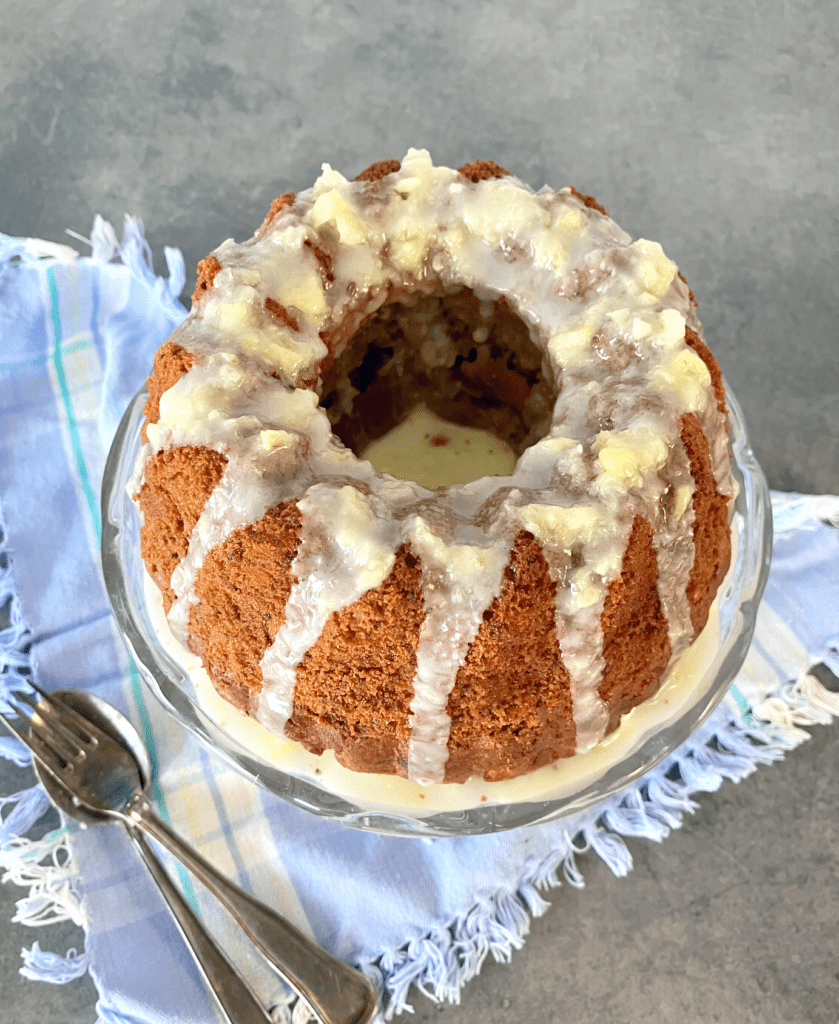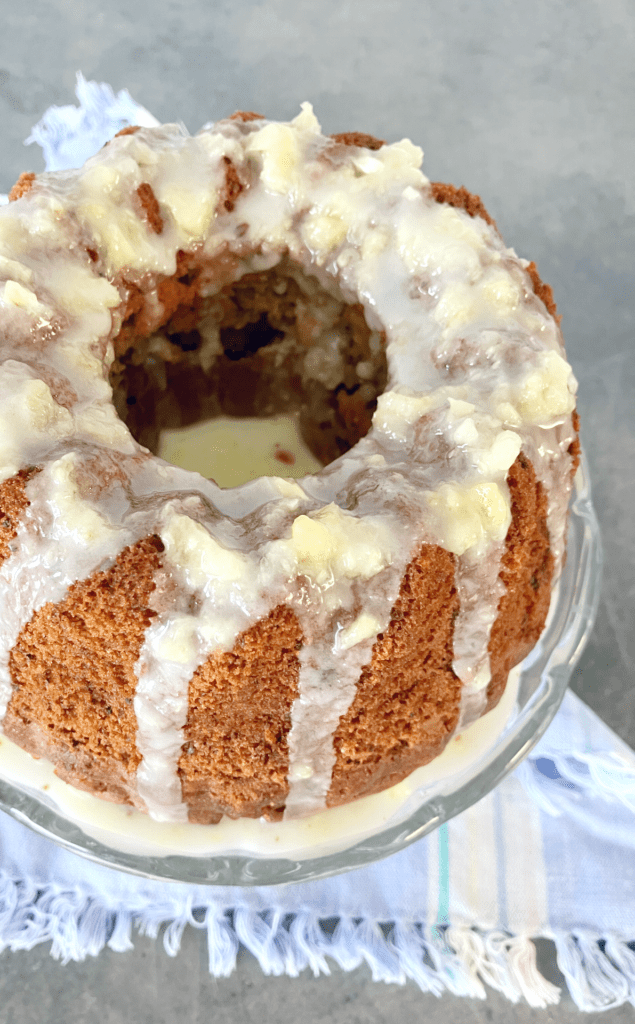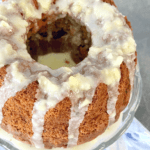Fresh Pineapple Spelt Cake (lower fat and sugar)
This fresh pineapple spelt cake is lower in fat and sugar. The soft sponge has poppy seeds, natural sweetness, and a pineapple glaze. The cake can be made with either regular white flour or spelt flour.
This recipe features in my 36 spectacular spelt flour cake recipes Which one is your favourite?

About The Culinary Jumble
As regular readers know, I had a blog before this one, called The Culinary Jumble. When I began using spelt more often in baking, and realizing there was no real discernible difference between regular flour and spelt flour, I decided to niche down a little and focus on baking with spelt. And the new blog was born.
I am slowly moving my recipes over from The Culinary Jumble and adapting them to use spelt flour. All recipes are tried and tested with the flour I originally made the recipes with, plus spelt. This means that for most of my recipes, like this pineapple cake, spelt, regular or a gluten free blended flour can be used interchangeably.
My fresh pineapple spelt cake
This time, the makeover takes the form of a fresh pineapple spelt cake. The original version featured chia seeds, but I had some poppy seeds that needed using up, so in they went. A simple swap, but one that adds a slightly different texture and visual appeal.
The pineapple I used this time was fresh, though tinned pineapple would work just as well and might even be more convenient depending on the season. The use of pineapple gives the cake a subtle tang that balances nicely against the sweetness, and the Greek yoghurt in the batter really helps bring out that fresh, fruity sharpness. It also pulls double duty by keeping the fat content in check while adding a lovely, moist texture. You can definitely taste the pineapple, but it doesn’t overwhelm the cake. It’s more of a background note, offering freshness and balance rather than dominating the whole flavour.
For the sweetener, I chose coconut sugar for its gentle caramel notes, but honestly, any sugar you have on hand will do the job just fine.
Using fresh pineapple (with substitutions)
This recipe uses fresh pineapple, which brings a lovely balance of sweetness and gentle tang to the cake. Once blitzed in a food processor, the pineapple blends smoothly into the batter, adding natural moisture and flavour without overwhelming the other ingredients. It’s subtle but noticeable. Just enough to give the cake its character.
If you don’t have fresh pineapple, tinned pineapple is a perfectly good alternative. Just be sure to drain it well first and give it a quick blitz to match the texture of crushed fresh pineapple. Any variety works: rings, chunks, or tidbits. Just as long as it’s not overly syrupy.
Fresh pineapple does have a slightly brighter flavour and firmer texture, but honestly, the cake works beautifully with either. It’s flexible and forgiving, which is exactly what you want in a simple, everyday bake like this one.
A simple pineapple glaze
The glaze for this cake couldn’t be easier: just crushed pineapple mixed with icing sugar. That’s it. It brings a fresh, fruity finish that pairs beautifully with the light tang of the cake itself. Because the pineapple isn’t strained, you’ll get tiny golden flecks and bits of fruit scattered through the glaze, which look gorgeous once spread over the cooled cake.
You can make it as thick or as thin as you like, depending on how much icing sugar you use. A thicker glaze gives more coverage and a stronger hit of sweetness, while a thinner one sinks into the sponge a little more. Either way, it’s a lovely finishing touch, with absolutely no need to overthink it. It’s one of those glazes that’s rustic in the best possible way. Quick, unfussy, and just the right balance to the soft crumb of the cake underneath.
What is coconut sugar, and is it healthier?
Coconut sugar is a natural sweetener made from the sap of the flower buds of the coconut palm. It’s often praised for being less processed than white sugar and for retaining some of its natural minerals, like iron, zinc, calcium, and potassium, as well as inulin, a type of fibre that may help slow glucose absorption.
That said, coconut sugar is still sugar, and your body processes it in a similar way to regular cane sugar. It does have a slightly lower glycaemic index than white sugar, meaning it may have a gentler effect on blood sugar levels, but the difference isn’t dramatic enough to call it a health food.
Where coconut sugar really shines is its taste. It has a lovely caramel-like flavour, somewhat like brown sugar, which pairs beautifully with warm, earthy, or fruity bakes, like this pineapple cake. It’s a great choice for recipes where you want a hint of richness without using refined white sugar.
If you don’t have coconut sugar on hand, you can easily swap it for light or dark brown sugar. Both give a similar depth of flavour and moisture. In a pinch, white sugar will also work, though you’ll lose some of the subtle richness and colour that coconut sugar brings. You can typically substitute coconut sugar 1:1 for most other sugars in baking, so no need for complicated conversions.
Why this is a lighter cake
This pineapple cake is on the lighter side, thanks to a few ingredient swaps. There’s less fat and sugar than in a traditional sponge, and instead of relying on butter alone, it uses a combination of vegetable oil and Greek yoghurt. The result is a cake that’s still soft and flavourful, but a little denser than a classic pound cake.
The Greek yoghurt plays a key role here. Not only does it reduce the overall fat content, it also adds moisture and a subtle tang that works really well with the pineapple. That said, yoghurt tends to make cakes slightly heavier, so if you’re expecting a fluffy, airy texture, this one leans more towards moist and tender with a close crumb. Think banana bread rather than Victoria sponge.
Of course, if you decide to add the optional pineapple glaze, the sugar content will go up a little. However, as the base cake itself is fairly restrained, making it a great everyday bake that doesn’t feel too rich or heavy.
Fresh Pineapple Spelt Cake with a Pineapple Frosting (lower fat and sugar)
Ingredients
Cake:
- 50g (¼ cup) sugar (see note 1)
- 30g (2 tbsp) butter (softened)
- 2 eggs (medium)
- 100g (½ cup) pineapple (see note 2)
- 50ml (3 tbsp + 2 tsp) vegetable oil
- 50g (¼ cup) Greek yoghurt
- 2 tbs pineapple juice
- 200g (1½ cups) flour (see note 3)
- ½ tsp bicarbonate (baking soda)
- 1 tsp baking powder
- 1 tsp vanilla sugar
- 1 tbs poppy seeds
Glaze:
- 50g (1¾ oz) pineapple (see note 2)
- icing / confectioners' / powdered sugar (as much as needed)
Instructions
Cake:
- Pre-heat the oven to 175°C (350°F) and grease your desired pan (I have used both a 9 x 5" loaf tin and 1 liter bundt).
- If using fresh or sliced pineapple, blitz it in a food processor until it is crushed. Remove and set aside.
- Using either a food processor or whisk, cream the butter and sugar, and then add in the eggs, one at a time.
- Add the crushed pineapple, pineapple juice, oil and yoghurt and continue to whisk until smooth.
- Sift the flour, baking soda, baking powder, vanilla sugar, and poppy seeds together and then add to the wet ingredients. Stir until just combined.
- Pour into the prepared tin and bake for around 30-40 minutes (depending on which pan you use) in the lower part of the oven.
- The cake is ready when an inserted skewer comes out clean. Start checking from about 30 minutes, and if using a bundt tin, you may need to cover the top to prevent it browning too much.
- Leave in the tin for a while, then turn out onto a wire rack and cool completely.
Glaze:
- Crush your pineapple (if it's not already done) and add just as much icing sugar as needed to create a glaze. You will have lovely thick bits of pineapple, which looks so pretty! Slather it over your cake and enjoy!
Notes
- I have used both brown and coconut sugar to make this cake (the images show a cake made with coconut sugar). However, you could also use granulated sugar.
- I used fresh pineapple in my cake, but have used tinned in the past. If your pineapple isn't crushed already, you will need to do this for both the cake and the frosting.
- I've used both a gluten free blend and spelt flour to make this cake. You could also use regular flour. You don't need to amend the measurements, just use the amounts stated.







1 thought on “Fresh Pineapple Spelt Cake (lower fat and sugar)”